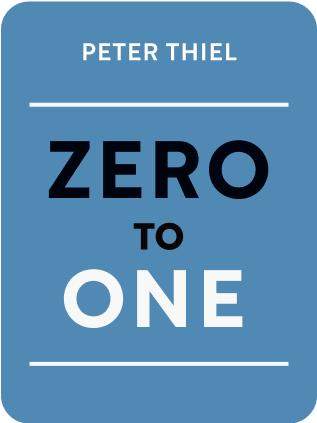

This article is an excerpt from the Shortform summary of "Zero To One" by Peter Thiel. Shortform has the world's best summaries of books you should be reading.
Like this article? Sign up for a free trial here .
What is the key to tech startup success? What are the key elements a tech startup needs to make a difference?
Peter Thiel believes that startups are the way to the future. It’s these new companies that will unleash new technologies we need to progress as a society. In his book Zero to One, Thiel shares five elements that a startup business must have if it wants to make this kind of impact: revolutionary technology, strategic timing, a great team, effective distribution, and enduring value.
Continue reading for Thiel’s insights on starting a tech company that makes a difference.
Starting a Tech Company
Thiel stresses the importance of creating new technologies, both for businesses and for society as a whole. But how do you actually do that? According to Thiel, you do it by starting a tech company. He observes that startups originate most new technologies, while established companies focus primarily on horizontal progress and individuals seldom have the resources to develop new technologies on their own.
Thiel goes on to offer his advice on how to start a profitable business, listing what he considers the elements of a strong startup venture. If any of these elements are weak, the startup is likely to fail. But if you’ve got all of them in good order, you’re on your way to building a great business.
| Why New Technology Comes From Startups In The Innovator’s Dilemma, Clayton Christensen elaborates on Thiel’s observation that established companies seldom create revolutionary technologies. According to Christensen, revolutionary innovations typically start out in markets that are too small to interest established companies, though they can grow exponentially from there. Meanwhile, to elaborate on Thiel’s point that individuals don’t usually have the resources to develop revolutionary inventions, financial consultants estimate that it takes a minimum of about $25,000 to develop a new invention. This estimate includes only $2,000 for engineering, implying that your invention only requires about half a -week of engineering labor. And it does not include any cost for setting up production. So this estimate would be realistic for a product like a simple phone app that a software engineer can create in a few hours and costs nothing to manufacture, but physical products and more advanced software products would cost considerably more, putting them out of reach for most individual innovators. |
1. Revolutionary Technology
First and foremost, Thiel asks whether you have an idea for a revolutionary technology to build your startup around. In other words, what great opportunity have you identified that everyone else has overlooked? As Thiel explains, there are two elements to answering this question:
First, have you really identified a great opportunity? Thiel cautions that making an incremental improvement to an existing technology is generally not a great opportunity. Instead, you need a breakthrough that provides fundamentally new capabilities, or, at the very least, increases existing capabilities by a factor of 10.
Second, are you the only one to identify this opportunity? If other people have already identified the same opportunity, then it’s probably not worth pursuing, because competition will consume your profits.
Shortform Commentary: Identifying Revolutionary Technology
Thiel says you need an idea for technology that can provide unique, revolutionary capabilities. In Blue Ocean Strategy, Kim and Mauborgne make a similar assertion and go on to describe analytical tools for assessing just how unique your idea is. One tool that helps you see at a glance just how unique your proposed product would be is their strategy chart. It consists of a two-dimensional line graph:
- On the horizontal axis, you list the characteristics or capabilities that your proposed product would provide.
- The vertical axis represents how much of each characteristic your product provides.
To make your strategy chart, you plot the value of each characteristic on the graph as a point and connect the points to create a strategy curve, both for your proposed product and for the closest alternatives that customers currently have. A generic example might look something like this:
As Kim and Mauborgne point out, if your product’s path closely follows another product (like Product X and Product Y in our example graph) then your proposed product is not unique enough to create an uncontested market. They also advise that if your proposed product curve is very flat (like Product Z), your offering may not be focused enough: You’re trying to be all things to all customers, and you’ll end up being a poor alternative for all of them.
In light of Thiel’s discussion, your proposed product also needs to score at least 10X higher than any other product on at least one characteristic. This is visible on the vertical axis of the graph, so Kim and Mauborgne’s strategy chart provides a way to visualize the uniqueness of your idea in terms of the value it provides to customers. This can help you determine if it is truly revolutionary.
2. Strategic Timing
Even if you’re the first to invent a revolutionary technology, Thiel asks you to consider whether it’s the right time to produce and market it. To illustrate his point, he contrasts the microprocessor market of the 1970s with the solar energy market of the early 2000s. Beginning in the 1970s, the capabilities of microprocessors increased exponentially, as did the market for them. The time for microprocessors to disrupt the market had come.
In contrast, in the early 2000s, there was a surge of interest in solar energy, but the capabilities of solar cells improved only slightly during this time. Eventually, the investment bubble burst and many solar companies failed. It was not the time for solar to disrupt the global energy market.
| Timing and Technology Is timing really separable from technological maturity? Thiel presents the solar energy bubble of the early 2000s as an example of failed timing, but it seems like the only reason that it wasn’t the right time for solar was that the technology wasn’t ready or wasn’t advancing quickly enough. Hypothetically, if a solar energy company had been able to double the efficiency of their solar panels each year from 2006 to 2010, they would have been able to take advantage of all the loans, grants, and investment capital available at the time to expand their production capabilities, and they would probably have done very well. As such, Thiel’s example seems to blur the distinction between timing and technological maturity. Nevertheless, timing can affect the success of your startup even if your core technology is solid. For example, as Thiel points out, both the technology and the timing were right for the microprocessor industry in the 1970s. But imagine what would have happened if Benjamin Franklin had invented a microprocessor in the 1770s. Even if it was a good processor, it would have gone nowhere at that time: The production costs would have been astronomical, because silicon processing infrastructure didn’t exist—he would have had to pay individual artisans to produce pure silicon in small batches, and other artisans to make chips from the silicon, a few at a time. And marketing would have been extremely difficult, because nobody was interested in microprocessors at the time—society hadn’t yet realized the usefulness of electricity, let alone electronic computers. Thus, timing is related to technological maturity, but in a broader sense. Your product needs to be revolutionary in its time (solar cells weren’t revolutionary in 2000), but not too far ahead of its time to be practical and attract interest (like a microprocessor in the 1700s). |
3. A Great Team
When you’re starting a company, Thiel says your team should be unified by your company’s unique mission. He also says it’s important to choose leaders who know each other well enough to be sure that both their technical skills and their personalities are complementary. A great combination of technical skills on your team won’t get you anywhere if the team members can’t get along. Thiel emphasizes that you also need a structure and clearly defined roles so everyone is aligned to move the organization forward. He explains that to establish this structure, you must make three decisions:
- Equity: Who will legally own the company? It’s not unusual for founders, investors, and employees all to have a share of ownership in a startup.
- Direction: Who will make the high-level decisions about what the company will do? In many startups, a board of directors consisting of the founders and investors fulfills this function.
- Operation: Who will figure out how to accomplish the company’s high-level objectives and take responsibility for getting the work done? Sometimes a founder assumes this responsibility, sometimes the company hires a chief executive officer (CEO) to do it, and sometimes this function is distributed among employees.
Furthermore, as you hire additional employees, Thiel emphasizes the importance of articulating your company’s mission to them. He advises hiring people who find your company’s unique mission compelling and want to work with the kind of people who are already on your team—not people who are just looking for money or special perks.
In particular, Thiel cautions you not to overpay your CEO. In his view, paychecks motivate people only in the short term because pay is derived from the present value of the company, not its future value. This can be especially problematic at the executive level since it’s crucial to have a CEO with a vision for building the company’s future. Paying your CEO too much can undermine her motivation to do whatever it takes to reach the company’s long-term goals.
Additionally, the CEO pay sets the standard for the rest of the company: If she draws a fat paycheck, her subordinates will expect proportionally high compensation. If she covers up problems to make the current situation look better and thereby protect her short-term interests, her subordinates will do likewise. But if she addresses problems head-on and works for the company’s growth in hopes of future rewards, this may inspire her subordinates to do the same.
| Hiring a Great Team In The Hard Thing About Hard Things, Ben Horowitz offers advice on hiring employees that both corroborates Thiel’s perspective and provides additional insight. Like Thiel, Horowicz emphasizes that your company’s unique mission should serve to unify and motivate your team. He prefers to call this mission your “vision,” and describes it as the story of what your company is capable of doing, why it matters, both to you and to the world, and how it sets you apart from every other company out there. When it comes to hiring employees, Horowitz echoes Thiel’s admonition to find people who see the success of the company as their route to personal success, not people whose personal ambitions run contrary to the company’s best interests. Additionally, he explains the importance of hiring for the particular strengths that will allow the new hire to excel in her role, rather than weeding out all the candidates who have weaknesses of any kind and hiring whoever is left. Of course, to do this you need to understand each role that you’re hiring for. This, in turn, requires clearly-defined roles and responsibilities, reinforcing Thiel’s point that everyone on the team should have a unique role. When it comes to dividing up equity, high-level direction, and day-to-day operation of the company, Horowicz argues that it’s crucial for the founders to take an active role in directing and operating the company. In his experience, the founders are the ones who really understand the company’s unique mission. They are the ones who can best articulate the mission to new hires and best translate it into tangible actions for people to work on. Without them, a startup will stumble off track. |
4. Effective Distribution
Thiel asserts that planning how to distribute your product is an integral part of designing your product. He explains that there are two considerations for planning your sales strategy:
- Customer lifetime value or CLV is the profit you earn over the course of your relationship with a customer. For example, if you sell automobiles at a profit of about $5,000 per car, and your average customer buys a new car once every 10 years for about 40 years, then your CLV is $20,000. Or, if you sell vitamins that a customer would take every day at a profit of $0.05 per tablet, and the average customer takes your vitamins for forty years, then your CLV is $730.
- The customer acquisition cost or CAC is the amount you spend to acquire a customer. For example, if you spend $1 million on marketing, and you get 5,000 new customers, your CAC is $200 per customer.
(Shortform note: The terms CLV (customer lifetime value) and CAC (customer acquisition cost) appear to have been coined by Robert Shaw and Merlin Stone in their 1988 book, Database Marketing. CLV is also abbreviated LCV (lifetime customer value) or LTV (lifetime value) instead of CLV by other sources.)
Thiel explains that your CLV determines what types of marketing you can consider because your CLV needs to be greater than your customer acquisition cost for you to make a profit.
(Shortform note: Other sources amplify this assertion, saying that for a product or service to be viable, the CAC should not exceed 30% of the CLV.)
Thiel discusses four types of marketing with different customer acquisition costs:
- Viral marketing is the least expensive type of marketing. It involves inviting just a few people to try out your product, typically via email or social media, and then relying on these first customers to spread the word. It is ideal for low-cost (or free) products that have a low CLV because it costs almost nothing and enables your customer base to grow exponentially.
- Mass advertising (such as television ads) can be expensive but has a low customer acquisition cost because it allows you to reach many potential customers at once. This makes it the method of choice for most consumer products.
- Direct sales are more expensive because your sales reps have to meet each customer personally. But for individual sales ranging from $10,000 to $100,000 in value, this personal attention is justifiable and may be necessary to build your customers’ confidence by showing them how your product can solve their particular problems.
- Complex sales are the most expensive because they require the personal involvement of your CEO to coordinate with multiple stakeholders on high-value sales (typically over $1 million) that your customer may perceive as high-risk.
| A Second Opinion on Distribution Channels In Crossing the Chasm, business and marketing consultant Geoffrey Moore discusses marketing and distribution channels for startup companies much like Thiel does. Thiel presents viral marketing as the cheapest marketing channel, suitable for products with low CLV. Conversely, Moore doesn’t treat viral marketing as a separate marketing channel. Instead, he argues that word-of-mouth (which is the basis of viral marketing) is always crucial for sales success, and the purpose of your marketing campaign is just to get word-of-mouth circulating. If you need to keep the CAC to a minimum, Moore recommends distributing your product via web-based self-service and using targeted advertising to get the word out about your product. He points out that digital advertisements targeted at the people whose interests and demographics are the best match for your product provide a much lower CAC than un-targeted mass advertising. Unlike Thiel, Moore doesn’t recommend using mass advertising, at least not for startups. A key part of his strategy is targeting a specific niche market that’s small enough for your startup to dominate. Mass advertising puts your product in front of a broad audience, but if your product is designed specifically for a small group of target customers, this is counterproductive. Moore’s advice on direct and complex sales is similar to Thiel’s but with a few additional nuances. Most notably, he describes a special type of complex sale in which a company is looking at using your product as a component in their product. For example, maybe you invent a better type of transmission and an automaker is interested in using it in their vehicles. In this case, the first people you need to win over to make the sale are the customer’s engineers, so you should post technical information about your product online, where engineers can find it—and stick to hard facts because engineers don’t respond well to promotional marketing. Offer to provide demonstrations or additional information so you can make contact with their engineers. Once you’ve convinced the engineers that your product is a good fit for their technical objectives, they can put your salespeople in touch with the executives who have actual purchasing authority. Moore also describes a few channels that Thiel doesn’t mention, including value-added resellers (VARs) and “Sales 2.0”. He says VARs are particularly useful for marketing hi-tech products to people who aren’t particularly tech-savvy, because the VAR provides local, personal training and support. Sales 2.0 represents an intermediate step between direct sales and online self-service: You have a website that provides general information up front, but when the user expresses interest by clicking on a link, the website connects her with a live sales representative. This hybrid system can be ideal for situations where the CLV is in between the level where you would use a direct sales model and the level where you would turn to mass marketing. |
5. Enduring Value
Your goal is to build a monopoly that will generate long-term profits by introducing a revolutionary product that no one else can match. Thiel observes that to do this, you need to be the first to introduce your product. That said, he also cautions that moving first is just a means to an end, not an end in itself.
| Can You Forecast Enduring Value? To assess whether your product has the potential to dominate the market 10 or 20 years down the road, you need to make predictions about the future. In Superforecasting, Philip Tetlock and Dan Gardner discuss the art and science of making predictions, focusing on the traits of “superforecasters,” people whose predictions are correct more often than random guesses. Superforecasters tend to consider everything from a variety of perspectives and are careful to avoid cognitive bias. They also tend to think about everything in terms of probabilities rather than absolutes, and they place more weight on aggregate statistics than on the details of any particular case. But most of all, superforecasters avoid making predictions more than one year in advance because studies show that even the best forecasters can’t accurately predict the state of the world several years from now. The one-year horizon implies that making accurate, detailed predictions about the market for your product 10 or 20 years in the future is probably not possible. Ultimately, you’ll discover whether or not your product has enduring value over time, but you can’t predict it up front. That said, it’s still prudent to avoid common biases and analyze your product’s market from as many perspectives as possible. In the end, your prediction may just be a guess, but at least it will be an educated guess. |

———End of Preview———
Like what you just read? Read the rest of the world's best summary of Peter Thiel's "Zero To One" at Shortform .
Here's what you'll find in our full Zero To One summary :
- Why some companies genuinely move the world forward when most don't
- How to build a company that becomes a monopoly (and why monopolies aren't bad)
- Silicon Valley secrets to selling products and building rockstar teams






